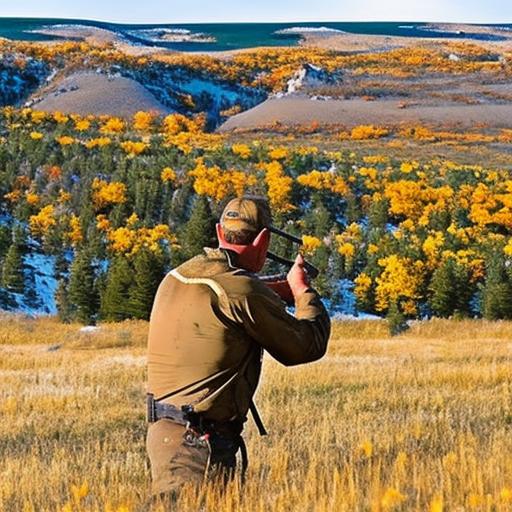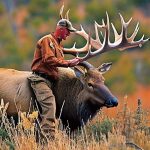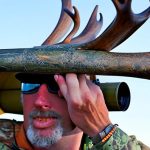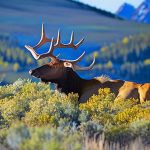Your cart is currently empty!

Unleashing the Thrill of Nebraska Elk Hunting: A Guide to a Memorable Outdoor Adventure

Nebraska’s elk hunting season is a highly anticipated time for hunters across the state and beyond. With its vast landscapes and diverse wildlife, Nebraska offers a unique and thrilling hunting experience for those seeking the challenge of pursuing elk. As the season approaches, excitement builds among hunters as they prepare for their upcoming trips, eagerly anticipating the adventure that awaits them in the wilderness.
Key Takeaways
- Nebraska’s elk hunting season offers a unique and beautiful experience for hunters.
- Proper planning and preparation are key to a successful elk hunting trip in Nebraska.
- Understanding elk behavior can increase your chances of a successful hunt.
- Choosing the right hunting gear is crucial for a comfortable and successful trip.
- Nebraska offers some of the best places to hunt elk in the country.
The Beauty of Nebraska’s Elk Hunting Season
During elk hunting season in Nebraska, hunters are treated to breathtaking landscapes and scenery. The state is known for its rolling hills, dense forests, and open prairies, providing a picturesque backdrop for the hunt. As hunters traverse through these stunning landscapes, they are immersed in nature’s beauty, creating a sense of awe and appreciation for the environment.
The thrill of the hunt is another aspect that makes Nebraska’s elk hunting season so special. The challenge of tracking and locating elk in their natural habitat adds an element of excitement and anticipation to the experience. The satisfaction of a successful trip, whether it be harvesting an elk or simply enjoying the adventure, is a feeling that cannot be replicated.
Planning Your Nebraska Elk Hunting Trip: Tips and Tricks
Before embarking on an elk hunting trip in Nebraska, it is important to do thorough research and obtain the necessary permits and licenses. Each year, the Nebraska Game and Parks Commission sets specific regulations and requirements for elk hunting, including bag limits and designated hunting areas. It is crucial to familiarize yourself with these regulations to ensure a legal and responsible hunting experience.
Choosing the right time of year for your trip is also essential. Elk hunting season in Nebraska typically runs from September to December, with different seasons for archery, muzzleloader, and rifle hunting. Consider factors such as weather conditions, elk behavior patterns, and personal preferences when selecting your preferred season.
Finding suitable accommodations and transportation is another crucial aspect of planning your elk hunting trip. Nebraska offers a range of options, from rustic cabins and campgrounds to hotels and lodges. Consider the proximity of your chosen accommodations to your hunting area, as well as the amenities and services they offer. Additionally, ensure that you have reliable transportation to and from your hunting locations.
Understanding the Behavior of Elk in Nebraska
| Behavior | Metric |
|---|---|
| Mating Season | Number of Mating Calls |
| Migration | Distance Traveled |
| Feeding Habits | Types of Vegetation Consumed |
| Social Structure | Size of Herds |
| Reproduction | Number of Calves Born per Year |
To increase your chances of a successful hunt, it is important to understand the behavior and habits of elk in Nebraska. Elk are known for their seasonal migration patterns, moving between different habitats in search of food, water, and shelter. By studying these migration patterns and identifying key areas where elk are likely to congregate, hunters can strategically plan their hunts.
Tracking and locating elk in the wild can be a challenging task. However, there are several tips and techniques that can help hunters in their pursuit. Pay attention to signs such as tracks, droppings, and rubs on trees, as these can indicate recent elk activity. Utilize binoculars or spotting scopes to scan the landscape for elk sightings. Additionally, consider using calls or scents to attract elk and increase your chances of a successful encounter.
Choosing the Right Hunting Gear for a Successful Trip
Having the right gear is crucial for a successful elk hunting trip in Nebraska. Essential items include a reliable firearm or bow, appropriate ammunition or arrows, camouflage clothing, sturdy boots, binoculars or spotting scopes, a backpack for carrying supplies, and field dressing equipment for processing harvested game.
When selecting hunting gear, it is important to consider your specific needs and budget. Research different brands and models to find equipment that is durable, reliable, and suited to your hunting style. Additionally, consider factors such as weight, comfort, and ease of use when choosing gear.
The Best Places to Hunt Elk in Nebraska

Nebraska offers a variety of popular hunting locations for elk enthusiasts. The Pine Ridge region in the northwest part of the state is known for its rugged terrain and dense forests, providing ideal habitat for elk. The Niobrara River Valley and the Sandhills region also offer excellent hunting opportunities, with their mix of grasslands, wetlands, and river systems.
While these popular hunting locations attract many hunters, there are also lesser-known spots that can be equally productive. Researching and exploring these hidden gems can lead to unique and rewarding hunting experiences. Consider reaching out to local hunters or wildlife management agencies for insider tips on lesser-known hunting areas.
Preparing for the Physical Demands of Elk Hunting
Elk hunting in Nebraska can be physically demanding, requiring hunters to be in good shape and prepared for long hours of hiking and tracking. It is important to start preparing well in advance of your trip by incorporating regular exercise into your routine. Focus on cardiovascular fitness, strength training, and endurance exercises to build the necessary stamina for the hunt.
Staying hydrated and well-rested during your trip is also crucial. Pack plenty of water and snacks to keep yourself fueled throughout the day. Take breaks when needed and listen to your body’s signals to avoid overexertion. Adequate rest and recovery will help you maintain focus and perform at your best during the hunt.
Hunting with a Guide vs. Hunting Solo: Pros and Cons
When planning an elk hunting trip in Nebraska, hunters must decide whether to hire a guide or hunt solo. Both options have their advantages and disadvantages, depending on individual preferences and experience levels.
Hunting with a guide can provide valuable expertise and local knowledge, increasing your chances of a successful hunt. Guides are familiar with the area, know where elk are likely to be found, and can offer guidance on hunting techniques. They can also assist with field dressing and processing game, making the overall experience more convenient.
On the other hand, hunting solo allows for a more independent and self-reliant experience. It provides an opportunity to test your skills and knowledge in the wilderness, relying solely on your own instincts and abilities. Hunting solo can also offer a greater sense of freedom and solitude, allowing you to fully immerse yourself in the natural surroundings.
Safety Tips for a Safe and Enjoyable Hunting Experience
Safety should always be a top priority when participating in any hunting activity. It is important to familiarize yourself with safety guidelines and regulations set by the Nebraska Game and Parks Commission. These guidelines include rules regarding firearm safety, hunting ethics, and proper handling of harvested game.
When venturing into the wilderness, it is crucial to take precautions to ensure your safety. Inform someone of your hunting plans and expected return time. Carry a first aid kit and know how to use it in case of emergencies. Dress appropriately for the weather conditions and wear blaze orange or other highly visible clothing to increase your visibility to other hunters.
Processing and Preparing Your Elk Meat: A Step-by-Step Guide
Once you have successfully harvested an elk, it is important to properly process and prepare the meat to ensure its quality and taste. Start by field dressing the animal as soon as possible after the kill. This involves removing the internal organs and cooling the carcass to prevent spoilage.
After field dressing, it is recommended to hang the carcass in a cool, dry place for several days to allow the meat to age. Aging helps tenderize the meat and enhances its flavor. Once aged, the meat can be butchered into various cuts such as steaks, roasts, and ground meat.
When cooking elk meat, it is important to remember that it is leaner than beef or pork, which means it can dry out more easily if overcooked. Consider marinating the meat or using moist cooking methods such as braising or slow cooking to retain its moisture and tenderness.
The Ethics of Nebraska Elk Hunting: Respecting the Wildlife and the Environment
Ethical hunting practices and environmental stewardship are essential when participating in elk hunting in Nebraska. It is important to respect the wildlife and their habitats, ensuring that hunting activities do not negatively impact the ecosystem.
Responsible hunters follow regulations and bag limits set by wildlife management agencies. They practice fair chase, which means pursuing game in a manner that gives them a reasonable chance to escape. They also strive to minimize waste by utilizing as much of the harvested animal as possible.
Preserving wildlife habitats is another important aspect of ethical hunting. Hunters should avoid damaging vegetation, disturbing nesting areas, or leaving behind any litter or waste. By leaving a minimal impact on the environment, hunters can help ensure that future generations can enjoy the same hunting opportunities.
Nebraska’s elk hunting season offers an exciting and rewarding experience for hunters of all skill levels. From the beauty of the landscape to the thrill of the hunt, there are countless reasons to plan a trip to Nebraska for elk hunting. By following the tips and guidelines outlined in this article, hunters can ensure a safe and enjoyable experience while respecting the wildlife and the environment. So, start planning your trip, gather your gear, and get ready for an unforgettable adventure in the wilds of Nebraska.
If you’re interested in Nebraska elk hunting, you might also enjoy reading this article on “How to Hunt Jackrabbits in California.” It provides valuable tips and techniques for hunting jackrabbits in the California region. Whether you’re a seasoned hunter or a beginner, this article offers insights on finding jackrabbits, choosing the right equipment, and improving your hunting skills. Check it out here.
FAQs
What is Nebraska elk hunting?
Nebraska elk hunting refers to the activity of hunting elk in the state of Nebraska, USA.
When is the elk hunting season in Nebraska?
The elk hunting season in Nebraska typically runs from September to December, with specific dates varying each year.
What are the requirements for hunting elk in Nebraska?
To hunt elk in Nebraska, hunters must have a valid Nebraska hunting license, a big game permit, and an elk permit. Hunters must also complete a hunter education course and follow all state hunting regulations.
Where can I hunt elk in Nebraska?
Elk hunting is limited to specific areas in Nebraska, including the Pine Ridge Unit and the Hat Creek Unit. Hunters must obtain a permit for the specific unit they wish to hunt in.
What weapons are allowed for elk hunting in Nebraska?
Hunters may use rifles, shotguns, or archery equipment for elk hunting in Nebraska. Specific regulations apply to each type of weapon.
What is the bag limit for elk hunting in Nebraska?
The bag limit for elk hunting in Nebraska is one elk per hunter per year.
What is the success rate for elk hunting in Nebraska?
The success rate for elk hunting in Nebraska varies each year and depends on factors such as weather and hunting conditions. In recent years, the success rate has been around 30-40%.

Herb has been a longtime lover of the outdoors. Whether it be hunting, camping, fishing or just getting outside to reset. Proud father and animal lover. Bourbon anyone?

by
Tags:
Comments

Categories
- Big Game Hunting (301)
- Deer (202)
- Reviews (3)
- Shooting (16)
- Slingshot (1)
- Small Game Hunting (42)
- Upland Hunting (126)
- Waterfowl Hunting (3)





Leave a Reply